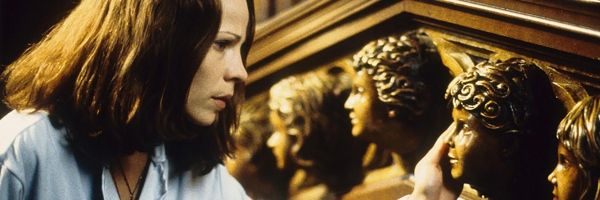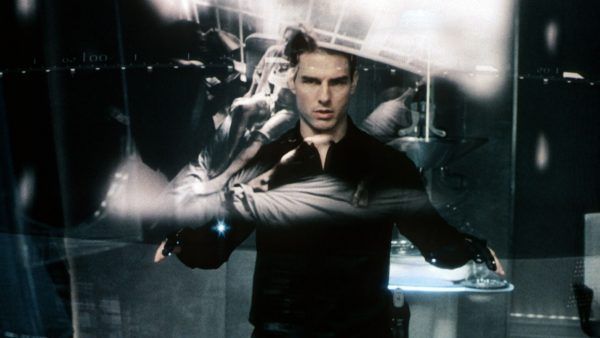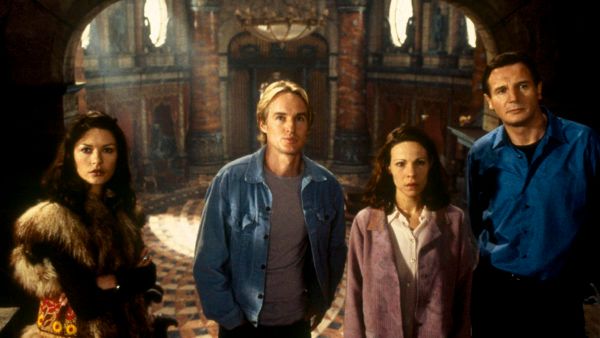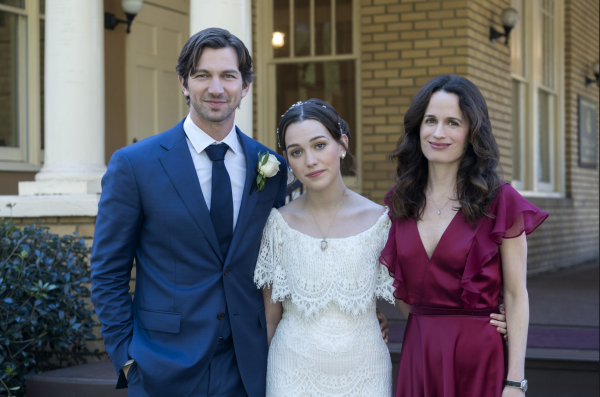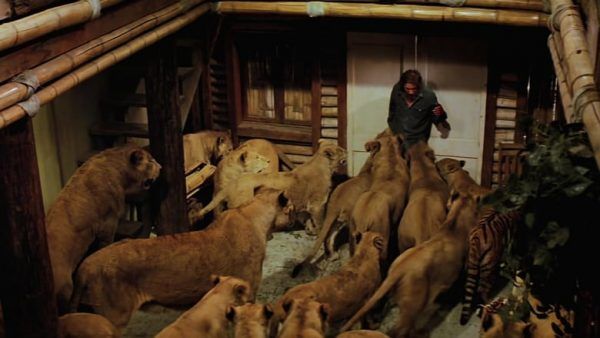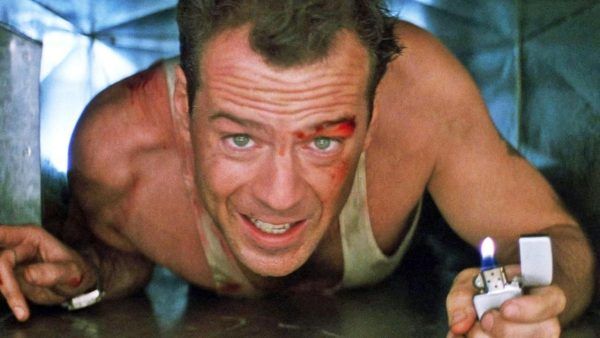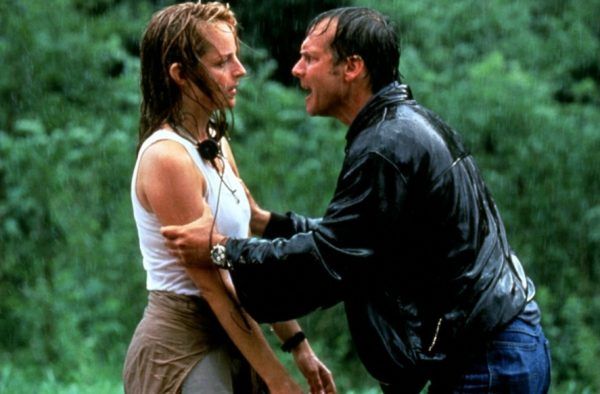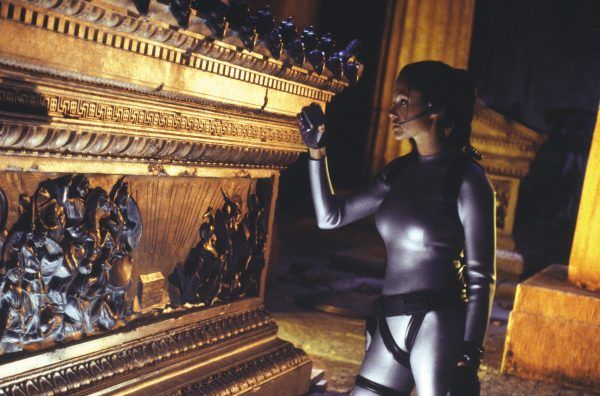As a cinematographer, Jan de Bont’s contributions to cinema cannot be overstated. He as an early, key collaborator of Paul Verhoeven’s, and later shot what was arguably Verhoeven’s most beautiful-looking American movie, Basic Instinct and made hugely influential, visually striking movies with Michael Chapman (All the Right Moves, The Clan of the Cave Bear), John McTiernan (Die Hard, The Hunt for Red October) and Lewis Teague (Cujo, The Jewel of the Nile). The influence of de Bont’s work is still felt today (just look at how much J.J. Abrams’ Star Trek cribs from The Hunt for Red October). As a director, de Bont (who, we must remember, shot the original Die Hard) crafted the most ingenious son-of-Die-Hard movie ever with Speed and directed the equally groundbreaking Twister, which used cutting-edge visual effects to take viewers into the eye of the storm.
We recently chatted with de Bont about his 1999 horror movie The Haunting. Produced by Steven Spielberg, with whom he had worked on Twister, it was a whiz-bang update of Shirley Jackson’s The Haunting of Hill House, complete with an all-star cast that included Catherine Zeta-Jones, Liam Neeson, Owen Wilson and Lili Taylor, it features over-the-top visual effects and a dreamy score by the legendary Jerry Goldsmith. The film is now (finally!) available on a wonderful-looking Blu-ray courtesy of Paramount Home Video and it was fun to get to chat with de Bont about his amazing career, swapping places with Spielberg on Minority Report, the hellacious shoot of his giant cat movie Roar and his thoughts on the current state of action cinema.
COLLIDER: I wanted to talk about The Haunting and how you got involved in this originally. Was it Spielberg that came to you with the idea of remaking this or doing a new spin on it?
JAN DE BONT: Well, actually, it was a different ... Spielberg had his own ... he was going to direct [The Haunting] originally. I was in the post process of Twister. And, suddenly, Tom Cruise became available for a particular period [for Minority Report]. And there was no way I was going to be ready [to direct] because I had been developing the script with Michael Tolkin and David Self, and he liked it. And then [Spielberg] said, "Listen, maybe we can change. Are you interested in changing? Because you cannot do it anyway. And Minority Report would be great with having Tom Cruise in the lead. We need a big star."
So, basically, that's how it developed. It was just like an equal switch in a way. I mean, I loved, of course, Minority Report, because I developed it for a long time, but this seemed also like a really interesting project. And, of course, I really didn’t want [The Haunting] to be a remake, because, number one, we had no rights to the other movie. We had rights to the book, which was more important, of course. I was totally not interested in remaking the old movie, because I liked it. I liked it a lot. It's definitely more of a drama. And this is more like a movie about an innocent, young woman, who actually is not so afraid of what's going on in that house.
It's a completely different story. It’s not a lot of shocks and horror, the typical horror elements. It's much more like a personality that has kind of seized this house, that is in a way scary looking in many facets. She sees it as something really beautiful and non-dangerous, which is almost the opposite.
Yeah, it's almost like a Close Encounters of the Third Kind type of thing.
DE BONT: Yeah. Definitely, leans a little bit more that way. Exactly. I mean she's the only one actually who can deal with it as well. The teacher and the other people that come there for the experiment, they really are no help at all. She's the only one who understands it, who understands the house and understands the guy who used to live there.
How involved was Spielberg in the shoot? There were reports from the time that he was directing reshoots. How did that work?
DE BONT: Well, it was not so much a re-shoot. It was an additional sequence, a small sequence. No, he came to the set several times. I mean, he was very interested. Of course, he'd like to stay involved, because he had developed it first with Michael Tolkin. It’s the same way I was interested in Minority Report, how that would go. It was quite a logical ... When you have developed a picture, you just don't step out of it, and that's the end of it. You don't do that.
What was like working with all these stars? Watching it again, it was like, Wow, these were some heavy hitters at the time.
DE BONT: Yeah, they were stars. I mean, Liam was ... I mean, I love Liam, because I had met him a few times. But the actors in that, they were not yet really, really big stars that they became later to most, because just like ... Especially Liam, I mean he did a whole series of action movies, which became ... I mean, I really liked him, because I liked what he did in some of the English movies he worked on.
But with most of the other ones, it's like ... Catherine Zeta-Jones was still kind of unknown. I mean, they became big, big stars. And Lili Taylor, who, to me, is brilliant. She was really quite unknown at the time completely. But I really wanted to have her, because I thought she would be extremely well-suited, because she has the kind of vulnerability that her character is supposed to have. It was so believable when she played some scenes. I thought it was totally perfect. I mean, I know that initially, everybody wanted to have a bigger star for that part, because it's actually the lead, but she was just the best. There was no doubt about it.
The other thing that was striking to me, re-watching it, was that it gets pretty intense. The fountain vomits blood and Owen Wilson gets his head ripped off. Were there battles with the MPPA at the time about how much you could do and show?
DE BONT: Yeah, there were some. There's always some kind of battle with them. I think it's maybe getting easier, or a little bit better, a little bit more ... You can defend it better. Yes, I mean we had to ... There's certain things we had to shorten and like the head coming off and things like that. And you can put a little bit more shadow on it and make it less visible, that kind of thing. But it happens almost in every movie, I think. It's like really ... Even in Speed, they had to soften certain things a little bit. And even with all the other movies I've worked on with other directors, it almost always happens.
This story, obviously, has lived on, because we recently got The Haunting of Hill House TV show that Spielberg was also involved in. Did you watch that at all?
DE BONT: No, I haven't watched it yet. I mean I plan to watch it. I've seen other versions. There's another one, a series that was before, another TV series, I think. Who was involved in that? It was ... I can't remember, but that also happened. That happened maybe 20 years ago. That's a very different approach you're seeing. And everybody can do its own thing. I mean why not? There's nothing ... Nobody can tell you what to do. I mean I like the original one. But I thought that this would be really ... could be a different version. It's a little bit like back to movie innocence a little bit in that regard.
Is TV something that you are drawn to at all? Would you do a TV show?
DE BONT: I've been involved in TV shows but not ... I mean I worked on Tales of the Crypt with Joel Silver for a while. I did some certain things in Germany for a TV series there. I mean it's not my first thing because it's so much work. And I really like to always focus on one project instead of having to make every movie a success, every individual part successful. It's a little bit more focused. I'm not against it because I love watching series. So you get involved... I mean I get involved personally in watching them. Of course, I never said I was going to do binge watching. But once you see one and you like it, you want to see the next one and the next one and the next one and then you go a week without seeing anything else.
Well, one of the more binge-able things this year has been Tiger King. And it made me think of your experience on Roar.
DE BONT: That's right. Yeah.
Not to open a can of worms that requires more therapy, but do you want to share your experience on that movie?
DE BONT: Yeah. I mean there is that. When you do movies like that, a lot of things go wrong. I mean almost you cannot ... I mean when I came here, it was the first movie I was working on. I was completely shocked that when I came here and I thought, oh, it's going to be like a small low budget movie, maybe six, seven weeks, eight weeks. We ended up being there three years. And I never even heard of it, anybody could work on a movie for that long. And it took that long because all of the ... We had a fire that burned down the whole set. I mean it had to be rebuilt. Then we had a year later a flood that destroyed the whole set with a lot of the animals escaping. So we all had to help capture the animals. I'm not an animal capturer. And each time I see them, I'm as afraid of them as anybody else would be. So I don't want to run into a lion in the bushes. Then I don't have a gun. There's a trainer with me. But I mean animals behave so differently once they're free. They're lions. They don’t want to come back. And then, of course, the injuries and, of course, my own injury. No. It happened. There's a lot of similarities in that regard.
You got to work with John McTiernan on a couple of hugely influential movies and some of the most beautiful-looking movies in any genre, I would argue. But when you were making Die Hard specifically, did you have any sense that you were crafting this game changer of a movie?
DE BONT: Yeah. The scenes that John and I ... who lives right behind me. I mean we're almost neighbors. And that we really wanted to get some new life in action movies because at that time they had become so stale and so flat and so repetitive. We really wanted to make a change. But, of course, we didn't know if anybody was going to go agree with that, that anybody would like it.
But by making it much freer, with a looser camera and only use three locations and make scenes in which the camera flowed from one to the other and actors who are actually doing some of their own stunts, many of their own stunts ... You can see it. They recognize that it is a special thing. You can see it on their faces that what they just did. It was a real thing not a fake thing done by a stunt double.
We hoped that it would be. When we started to put it together, I thought it was fantastic. And there's definitely I think it totally reenergizes the genre. But we didn't know until the movie was released. And then, of course, that's exactly what happened.
What do you think of action cinema today and, particularly, the way that it's shot? Are you a fan of the handheld-y stuff?
DE BONT: Well, the reality is that I've always done handheld. But I don't want the handheld to be that visible. I do not want to draw attention to it. The only thing that you notice ... If it's too shaky, we'd do it again. That would be absolutely not effective. It's basically trying to be the point of view of the audience being there. So I wanted to create a sense that there's some life to the camera. So it's not that static, non-moving, tied-to-the-ground camera position. It is like if the camera moves to the left and the right, you can see a little bit better. The camera takes the position of somebody that wants to know more, that wants to see more. It's investigative. That is really curious what is going to happen and how people react. But no. I do not like shaky camera as a shaky camera as a style phenomenon.
Also, I think action movies today is too much visual effects. I mean I know that Twister was one of the first ones. But I also could already see the incredible dangers looming up. It's that so many things would be taken over by visual effects instead of physical effects. There's nothing you can duplicate better by visual effects if you can do it with a real action sequence. There's car crashes. I've seen that happen for real. It is so much better. There's no comparison. And almost I mean everything I see right now is almost all the same. So now we're getting into a new similar situation as before Die Hard was made. It has to be reinvented again, that genre, because it's becoming stale. The audience is seeing the visual effects. And we know the exaggeration of the visual effects. It kind of kills the story a little bit. It kills the presence of the characters in a movie. It's awful. It's really not a great situation.
The Haunting has a lot of visual effects too. But the house was obviously a lot there and the house itself is amazingly designed.
DE BONT: Yeah. Exactly. But that's what's actually ... A lot of that was also was on camera. That whole collapsing of the room, for instance. There was a real set. We could move all the panels and they could telescope in and out. Of course, when it becomes like the creature appears, you cannot make that in real life. But, yeah there are some shots with some of the statues moving. In hindsight, I wish it was less, that it would have been more subtle. But it was kind of written like that. They really wanted to move. I'd much more rather have it been, Did I see it move or didn't I see it move? You know what I mean? That would have been better.
Did you ever have an idea for a third Speed? And would you come back for another Speed?
DE BONT: It depends on how the story is, I think. Generally, I'm not a huge fan for sequels. I had in my contract that I would do a sequel. If you have to, you have to have the cast to want to come back too because, otherwise, you have to tell a whole new movie. Because some of the first one was so much centered around him and about him, the awkwardness a little bit in him being a hero. And that awkwardness of being in a position to be a hero is ... That worked really well for him but it doesn't work well for other actors. And it's really hard to find that same kind of feeling back.
Did you have any favorite memories from Speed?
DE BONT: Yeah. I don't know. There's one scene that I was actually happy about that ... how we achieved it is when the bus jumps across the bridge. Because nobody knows that when we were going to shoot it the first time and everything was set up with a lot of cameras. And then the bus driver, the stunt driver, he got afraid at first. We thought he's not going to make it. He's not going to make ... And he sped up and sped up and sped up. And so he did make the jump. He went way beyond where he was supposed to land. But, unfortunately, he landed where all the cameras were because the cameras were farther away, so they could film it coming towards them. And he landed right on top of a group of cameras. And not only that, so we couldn't use any of it because most of the cameras had missed because they never saw the landing.
So the studio called in and said, "How did it go? How did it go?" "We didn't get it yet because we had some problem with one of the engines in the car. But we're going to try it again, pretty soon." And then we did it again. We didn't tell them we did it again when they do it. And then the second time the guy was really ... We had a different stunt driver. But there was also something that's wrong. So he did it right, but he was so nervous, he bit on his tongue. He bit a part of his tongue off when he landed, which is also not very good. So we never told anyone that either. But it still makes it look like a single jump. It looks relatively seamless, which it really wasn’t.
Did you hear about Twister being re-booted? Do you have any thoughts about that?
DE BONT: I read that like a month or two ago. I said, "Wow. Are they going to do the F5 now? I bet you that's what it is." You cannot do it by making it bigger. That as a movie hardly ever works. You have to come up as a ... with people actually involved in it. You cannot just ... It's like I'll work on the destruction scene. We're going to get worse and whole cities are going to get destroyed. That's exactly like falling in the trap of having the special effects completely take over.
Can I ask you sort of what you've been up to? Because it's been almost 20 years since Tomb Raider: Cradle of Life.
DE BONT: I have been working with several projects. Some of them the studio didn't want to make or wasn't interested in at the time, although, they got made later. And it became a little bit too hard to be honest on making movies because it became somewhat directed by groups of executives at the studio who kind of wanted ... They all believed that they are better directors and better filmmakers. Of course, it's never the case. But that's what they believe. And yet that endless fighting against those groups is really, really, really, really tedious. And you can ask every director. They all will agree with that. It has become even more so right now. The creativity level has gone down to like a kind of corporate directing. They find somebody who is willing to do the way they want it. And that's not always a guarantee for a good product. You know?
I know. But we need you back. You know what I mean?
DE BONT: Yeah. Well, but I think it's that time that it gets reinvented again, this type of ... To me, it's kind of a really tepid action movies. I know exactly what's going to happen. I know exactly what the effects will be before I see it. You know what I mean? That's not a good thing.
De Bont’s The Haunting is on Blu-ray and Digital HD now from Paramount Home Video.

